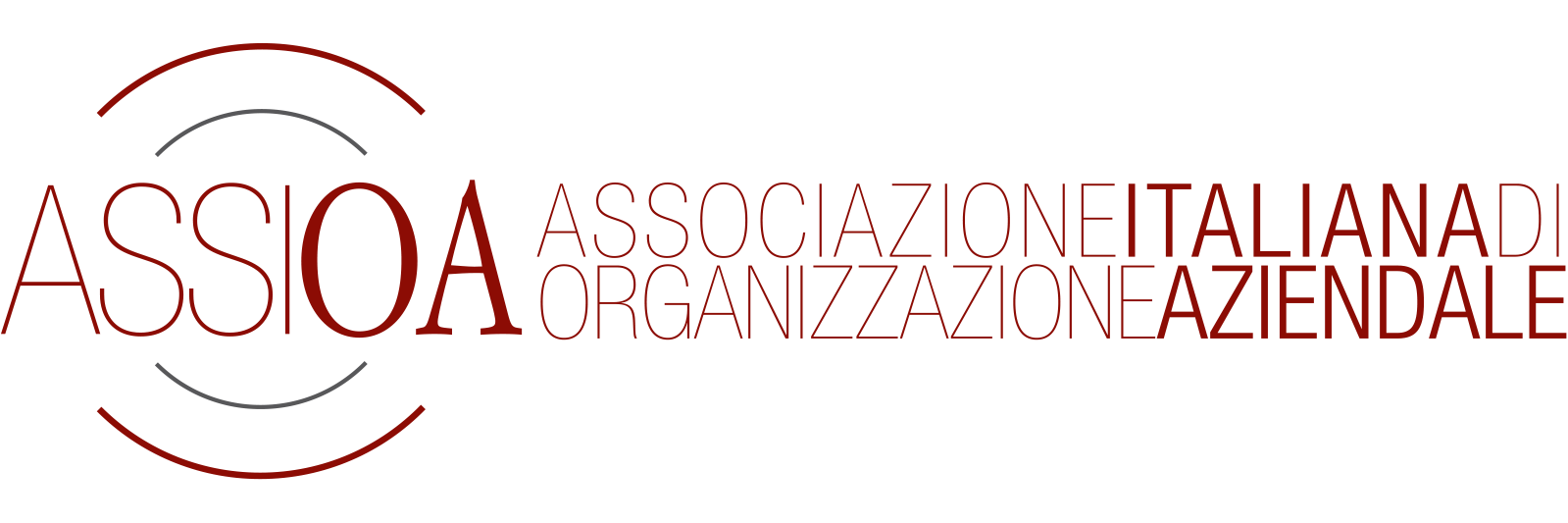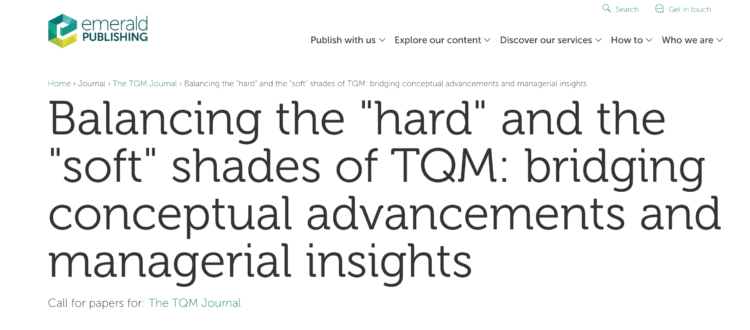Balancing the “hard” and the “soft” shades of TQM: bridging conceptual advancements and managerial insights
Submissions open: 8th August 2021
Submissions close: 31st January 2022
Guest Editors
Luca Gnan, Full Professor of Organization Studies at the Department of Management & Law, University of Rome “Tor Vergata” Rome, Italy, luca.gnan@uniroma2.it
Rocco Palumbo, Senior Researcher of Organization Studies at the Department of Management & Law, University of Rome “Tor Vergata” Rome, Italy, rocco.palumbo@uniroma2.it
The research field
The success of Total Quality Management (TQM) initiatives relies on a balanced mix of “hard” and “soft” factors (Gadenne and Sharma, 2009). Even though scholars are achieving a growing awareness of “soft” TQM, this topic has been mostly investigated on its own; conversely, the interdependencies between the “hard” and the “soft” sides of TQM are under-researched (Rahman and Bullock, 2005; Ershadi et al., 2019; Khalili et al., 2019). Besides, it is not easy to clearly define what is meant by “soft” TQM issues. Indeed, the “soft” domain includes a variety of strictly interrelated factors (Lau and Idris, 2001). Firstly, it involves macro-level dimensions – such as organizational politics, strategy making, organizational intelligence, organizational design, organizational culture and ethics, organizational identity, and organizational symbolism – that represent the ground where “hard” TQM initiatives take roots (Svensson and Wood, 2005; Edwards, 2007; Tenji and Foley, 2019). Secondly, it includes meso-level dynamics – i.e., organizational learning, decision making, organizational change, organizational sensemaking and sense giving, organizational communication, organizational development, and conflict management – that boost (or hamper) TQM initiatives (Chadwick, 2012; The et al., 2014). Thirdly, micro-level factors – including cognition, intuition, awareness, leadership, motivation, employees’ empowerment and engagement, and interpersonal communications and collaboration – are crucial soft ingredients of the recipe for successful TQM (Pool, 2000; Mohammad Mosadeghrad, 2014). The macro, meso, and micro dimensions of TQM find synthesis in Human Resource Management Practices (HRMP), that are intended to make the “soft” side of TQM tangible (Graham et al., 2014). More specifically, HRMP have been presented as practical tools to combine the “soft” issues and the “hard” components of TQM, enacting business excellence and sustaining it in the long-run.
Where are we now?
“Soft” TQM is attracting the increasing attention of scholars and practitioners interested in TQM and the organizational and managerial determinants of business excellence (Lasrado, 2019; Escrig-Tena et al., 2019). Even though it is generally believed that the “hard” and the “soft” side of TQM should go hand in hand, previous research has primarily focused on peculiar “soft” factors, overlooking their systemic nature. Most of the scholarly efforts have been targeted to investigate the role of singular “soft” factors in facilitating or hindering the implementation of “hard” TQM interventions (Sinha et al., 2016; Abdullah and Tarí, 2017). Conversely, only a few attempts have been made to comprehensively unravel the implications of “soft” TQM on the achievement of business excellence (Georgiev and Ohtaki, 2019). To the best of our knowledge, the interplay between the macro, meso, and micro dimensions of “soft” TQM has not been investigated in the scientific literature. Finally, the role of HRMP in eliciting the softness of TQM and in making it manageable for the purposes of quality improvement has not been thoroughly examined.
Where should we go?
This special issue has a twofold purpose. On the one hand, it intends to push forward what we currently know about “soft” issues in the TQM discourse, paving the way for a systematic conceptualization of factors that determine business excellence. Proposing a synoptic view of the macro, meso-, and micro-layers of “soft” TQM, it emphasizes HRMP as a managerial bridge to mould the softness of TQM interventions and embed them in hard TQM initiatives. On the other hand, it aims at collecting some practical evidence and managerial insights into the ingredients that are needed in the recipe for sustainable business excellence, envisioning the step-by-step process toward quality improvement. Whilst intangible factors – including, as illustrative examples, organizational culture (Psychogios and Wilkinson, 2007) and employees’ awareness (Vouzas, 2007) – have been largely discussed as requisites for TQM success, conceptual advancements and empirical researches investigating the interaction between “hard” and “soft” TQM issues are still scarce. From this point of view, this special issue strives for filling a relevant gap in scientific knowledge, providing innovative perspectives into the theory and practice of TQM.
How can we get there?
The soft side of TQM has been usually considered to be a “contingent” variable in the analysis of “hard”-based interventions aimed at enhancing organizational performances and increasing customer satisfaction (Imeri et al. 2014). Lack of awareness of the interplay between the “soft” and “hard” facets of TQM generates ambiguity in the acknowledgment of their effects on organizational performance. We contend that the three (macro, meso, and micro) layers of soft TQM are strictly interrelated, being concomitantly involved in organizational interventions that are intended to the achievement of business excellence (Cooney and Sohal, 2002). Beyond composing the “social” and the “human” sides of TQM, soft issues enact the organizational commitment to quality improvement and allow people to develop a coherent organizational sense-giving of plans, structures, operations and procedures designed for business excellence. The soft dimensions are moulded into managerial tools by Human Resource Management Practices (HRMP), such as employees’ recruiting and selection, training, evaluation, and development (Wilkinson et al., 1991; Wilkinson, 1992), that are intended to: 1) introduce TQM interventions and integrate them with conventional HRM tools (Simmons et al., 1995); and 2) sustain the engagement and the involvement of employees in continuous quality improvement (Keng Boon et al., 2007). The Ability-Motivation-Opportunity (AMO) model (Appelbaum et al., 2000) provides an insightful theoretical background against which the enacting and maintenance roles of HRMP can be conceptualized. Ability and skills development (A) is intended to empower employees and to make them aware of the organizational strategies and practices that are implemented to achieve business excellence; therefore, the enhancement of the HR abilities allows them to build a micro-level basis to launch and sustain TQM initiatives. Motivation enhancing practices (M) connect the micro and the meso-levels of soft TQM, creating employees’ participation and supporting the processes of organizational sense-making and sense giving. Opportunity building (O) relies on knowledge exchange, team working, and problem-solving, shaping the macro dimensions of TQM and sustaining business excellence as a philosophy inspiring the entire organization. In sum, HRMP allow the “hard” and the “soft” sides of TQM to be merged, triggering a fully-fledged approach to business excellence that concomitantly relies on abilities, motivation, and opportunities.
What are we looking for?
This special issue is especially interested in conceptual, empirical, and hybrid papers that aim at shedding light on the interplay between “soft” and “hard” TQM issues and at identifying the ingredients that are needed to prepare the “excellent” TQM cocktail. Anticipated list of themes includes, but is not limited to:
• Conceptualizing the “soft” side of TQM;
• The narratives of TQM inside and outside organizations;
• The interplay between Organizational Culture and TQM;
• Organizational identity, organizational sub-identities, and TQM;
• Organizational change, organizational learning, and TQM;
• Sensemaking, sensegiving and the “rhetoric” of TQM;
• Harnessing organizational conflicts to sustain TQM;
• Managing the “soft” side of TQM;
• The “Human Resource Management Practices” for the implementation of TQM;
• Leadership and TQM;
• The roles of senior managers and middle managers in achieving business excellence;
• Abilities, Motivation, Opportunities and the journey through business excellence;
• Employees’ awareness and TQM at the bottom of the organizational pyramid;
• Employees’ empowerment in TQM interventions;
• Employees’ involvement in TQM interventions;
• Recruiting appropriate human resources to sustain TQM;
• Training human resources for sustainable quality excellence;
• Motivating people to sustain business excellence;
• Evaluating human resources in a TQM perspective;
• Assessing the “soft” implications of TQM interventions;
• “Co-producing” and “co-creating” the soft side of TQM;
• Balancing the “hard” and the “soft” ingredients of TQM;
All types of papers – including conceptual articles, literature reviews, case studies, longitudinal and cross-sectional empirical researches intended to unravel the softness of TQM through valuable practice-oriented evidence – are welcome in this special issue.
Manuscript submission and review process
In preparing of manuscripts, authors are expected to follow the TQM author guidelines, that can be found here. All submissions to be made via the TQM Journal ScholarOne manuscript submission portal, located at: https://mc.manuscriptcentral.com/tqm
All papers should be submitted in English. Non-native English speakers are urged to have their manuscript proofread prior to submission. All submissions will be screened by the guest editors, and if they fit to the topics and have sufficient quality, they will be sent out to a team of reviewers to undergo the usual double-blind peer review process.
The deadline of submission is 31st January 2022.
Special opportunity for prospective authors
The Guest editors are planning to organize a “Paper Development Workshop”, that will be host by the Department of Management & Law of the University of Rome “Tor Vergata” (Via Columbia, no. 2, 00133, Rome, Italy) on July 15th 2021. Prospective authors may consider submitting a short paper to the “Paper Development Workshop” by May 31st 2021. Even though participation in the event does not automatically imply paper acceptance in the Special Issue, prospective authors who will attend the “Paper Development Workshop” will collect relevant insights that will contribute to enhancing the quality of their research. For further information, please get in touch with Luca Gnan (luca.gnan@uniroma2.it) or Rocco Palumbo (rocco.palumbo@uniroma2.it).
Keywords
Soft TQM; Human Resource Management Practices; Business excellence; Human side of TQM; Organizational quality
References
Abdullah, M.M. and Tarí, J.J. (2017), “Hard quality management and performance: the moderating role of soft quality management”, International Journal for Quality Research, Vol. 11 No. 3, pp. 587-602.
Appelbaum, E., Bailey, T., Berg, P. and Kalleberg, A.L. (2000), Manufacturing advantage: Why high-performance work systems pay off, London: ILR Press.
Chadwick, P. (2012), “Organizational change and TQM”, in P. Nightingale and M. O’neil (Eds.), Achieving Quality Learning in Higher Education (pp. 119-146). London: Taylor & Francis.
Cooney, R. and Sohal, A. (2002), “The Human Side of Total Quality Management”, in D. Holman, T.D. Wall, C.W. Clegg, P. Sparrow and A. Howard (Eds.), The New Workplace: A Guide to the Human Impact of Modern Working Practices (pp. 37-54). Hoboken, NJ: Wiley.
Edwards, T. (2007), “Organizational politics and the “process of knowing”: Understanding crisis events during project-based innovation projects”, European Journal of Innovation Management, Vol. 10 No. 3, pp. 391-406.
Ershadi, M.J., Najafi, N. and Soleimani, P. (2019), “Measuring the impact of soft and hard total quality management factors on customer behavior based on the role of innovation and continuous improvement” TQM Journal, Article published ahead of print. Doi: 10.1108/TQM-11-2018-0182.
Escrig-Tena, A., Garcia-Juan, B. and Segarra-Ciprés, M. (2019), “Drivers and internalisation of the EFQM excellence model”, International Journal of Quality & Reliability Management, Vol. 36 No. 3, pp. 398-419.
Gadenne, D. and Sharma, B. (2009), “An investigation of the hard and soft quality management factors of Australian SMEs and their association with firm performance”, International Journal of Quality & Reliability Management, Vol. 26 No. 9, pp. 865-880.
Georgiev, S. and Ohtaki, S. (2019), “Critical success factors for TQM implementation among manufacturing SMEs”, Benchmarking: An International Journal, Article published on-line ahead of print. Doi: 10.1108/BIJ-01-2019-0037.
Graham, N.K., Arthur, Y.D. and Mensah, D.P. (2014). “Managerial role in ensuring successful total quality management programme in Ghanaian printing firms”, The TQM Journal, Vol. 26 No. 5, pp. 398-410.
Keng Boon, O., Arumugam, V., Samaun Safa, M. and Abu Bakar, N. (2007), “HRM and TQM: association with job involvement”, Personnel Review, Vol. 36 No. 6, pp. 939-962.
Khalili, A., Ismail, M.Y., Karim, A.N.M. and Che Daud, M.R. (2019), “Quality management practices and sustainable performance: Examining the role of soft TQM as mediator”, International Journal of Industrial and Systems Engineering, Vol. 31 No. 2, pp. 250-277
Imeri, S., Kek̈ale, T., Takala, J. and Liu, Y. (2014), “Understanding the impact of ‘hard’ and ‘soft’ elements of TQM in South-east European firms”, Management and Production Engineering Review, Vol. 5 No. 3, pp. 9-13.
Lasrado, F. (2019), “TQM, AMO, and Factors Impacting Organizational Creativity and Innovation”, in F. Lasrado (Ed.), Fostering Creativity and Innovation (pp. 35-49). Cham: Palgrave.
Lau, H. and Idris, M. (2001), “The soft foundation of the critical success factors on TQM implementation in Malaysia”, TQM Magazine, Vol. 13 No. 1, pp. 51-60.
Mohammad Mosadeghrad, A. (2014), “Why TQM programmes fail? A pathology approach”, The TQM Journal, Vol. 26 No. 2, pp. 160-187.
Pool, S. (2000), “The learning organization: motivating employees by integrating TQM philosophy in a supportive organizational culture”, Leadership & Organization Development Journal, Vol. 21 No. 8, pp. 373-378.
Psychogios, A.G., and Wilkinson, A. (2007), “Exploring TQM awareness in the Greek national business context: between conservatism and reformism cultural determinants of TQM”, The International Journal of Human Resource Management, Vol. 18 No. 6, pp. 1042-1062.
Rahman, S. and Bullock, P. (2005), “Soft TQM, hard TQM, and organisational performance relationships: an empirical investigation”, Omega, Vol. 33 No. 1, pp. 73-83.
Simmons, D., Shadur, M. and Preston, A. (1995), “Integrating TQM and HRM”, Employee Relations, Vol. 17 No. 3, pp. 75-86.
Sinha, N., Garg, A. and Dhall, N. (2016), “Effect of TQM principles on performance of Indian SMEs: the case of automotive supply chain”, The TQM Journal, Vol. 28 No. 3, Doi: 10.1108/TQM-10-2014-0086.
Svensson, G. and Wood, G. (2005), “Corporate ethics in TQM: Management versus employee expectations and perceptions”, the TQM Magazine, Vol. 17 No. 2, pp. 137-149.
Teh, P.L., Yong, C.C. and Lin, B. (2014), “Multidimensional and mediating relationships between TQM, role conflict and role ambiguity: A role theory perspective”, Total Quality Management and Business Excellence, Vol. 25, pp. 1365-1381.
Tenji, T. and Foley, A. (2019), “Testing the readiness of an organisational culture profile to a TQM implementation”, the TQM Journal, Vol. 31 No. 3, pp. 400-416.
Vouzas, F.P. (2007), “Assessing managers’ awareness of TQM”, the TQM Magazine, Vol. 19 No. 1, pp. 62-75.
Wilkinson, A. (1992), “The other side of quality: ‘soft’ issues and the human resource dimension”, Total Quality Management and Business Excellence, Vol. 3 No. 3, pp. 323-330.
Wilkinson, A., Allen, P. and Snape, E. (1991), “TQM and the Management of Labour”, Employee Relations, Vol. 13 No. 1, 24-31.



